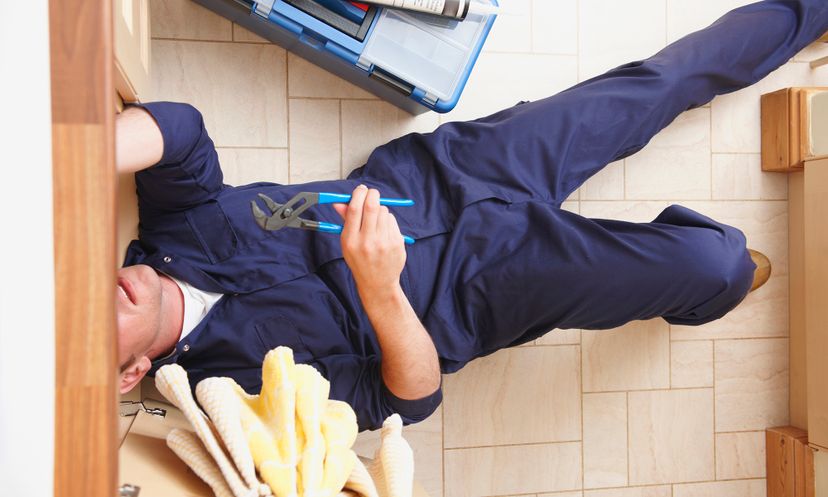The Ultimate Basic Plumbing Quiz
Estimated Completion Time 3 min
"
Image: Dave and Les Jacobs/Blend Images/Getty Images
About This Quiz
Something we all tend to take for granted at home is the plumbing system. Although it is usually reliable, problems can occur. Take this quiz and see how you can repair some of the common problems.
START QUIZ
What basic laws of nature does plumbing follow?
conductivity, acceleration and motion
gravity, pressure and water seeking its own level.
motion, elasticity and resilience
The basic natural laws of plumbing are gravity, pressure and water seeking its own level.
What are the two sub-systems in your home plumbing?
incoming freshwater and outgoing wastewater
low pressure water and high pressure water
One brings in freshwater, while the other removes wastewater.
Can there be overlapping of the two subsystems?
There can be an underground overlap.
An overlap is recommended when the pipes are wider than two inches.
Because of pollution issues, there must be a separation.
Definitely not -- the wastewater sub-system could pollute the freshwater if there were an overlap.
What seals the trap that prevents sewer gases from entering the household drains?
air admitted by vent stacks and vent pipes
The vent stack and vent pipes admit air to keep the trap sealed.
Is there any reason for individual fixtures to have stop valves?
Yes, but only if there is no overflow pipe.
No, it just adds to plumbing installation costs.
You can thereby localize turning off water.
Individual stop valves permit water to be turned off at that particular fixture only and not the main water supply.
Which of the following is regarded as a normal temperature setting for a home water heater?
An adequate temperature is 120 degrees F.
Why would you use an adequate temperature instead of the highest possible?
ensures a smoother flow of hot water
reduces wear on the pipes
It is simply more economical and sufficient for most circumstances.
Are there major differences between sewer and septic systems in your home?
The only difference is in the type of pipes used.
One uses pressure and the other uses gravity.
Both systems are basically the same.
What degree of pressure is required to ensure smooth drainage?
No pressure is required. It's a matter of gravity.
What would happen if there were no air supply from the vent on the roof?
Smells from the sewer would enter the system.
Waste water would not flow out.
Nothing, it is used mainly to add rainwater to the system
The wastewater would not flow out and the water in the traps would need to be siphoned out.
In a modern efficient drainage system, is a sink trap really necessary?
Only when pipes of three inches or less are used.
It is necessary only when there is no sink filter.
The sink trap prevents dangerous sewer gas from entering the home and also prevents some waste from entering the pipes, thereby blocking them.
What are the most common causes of sink blockages
toilet paper and air freshener
solidified detergents and toothpaste
Hair and grease are the most common causes of sink blockages.
When used in a the context of plumbing, what does DWV stand for?
It stands for drain-waste-vent.
How can you get to know the drainage system better?
Ask your plumber to draw you a diagram.
Examine the pipes under your house or in the basement.
The best way is to examine the pipes in the basement or crawl space under the house.
What is a fixture?
any device using freshwater and wastewater
All devices that use freshwater and allow the flow of wastewater are considered to be fixtures.
Before changing a pipe in your house, what should you do?
Check your plumbing code.
Compare quotes from a few plumbers.
Check first with your plumbing code what is permitted.
Why would you want to do your own plumbing work?
protest local plumbing codes
weaken the plumbers' stranglehold
You can save a lot of money.
What is a bridge in a plumbing system?
where one pipe crosses above another
meeting point of the two subsystems
A bridge is where the two subsystems (incoming and outgoing water) meet, such as a sink.
To save time in the event of a plumbing problem, what should you do?
Have your plumber on speed dial.
Have a remote control for the water supply.
Get to know the workings of your plumbing system.
How does the drainage system work?
Drainage pipes are angled downward and gravity pulls the waste down.
You Got:
/20
Share on Facebook
Share on Facebook
Dave and Les Jacobs/Blend Images/Getty Images
